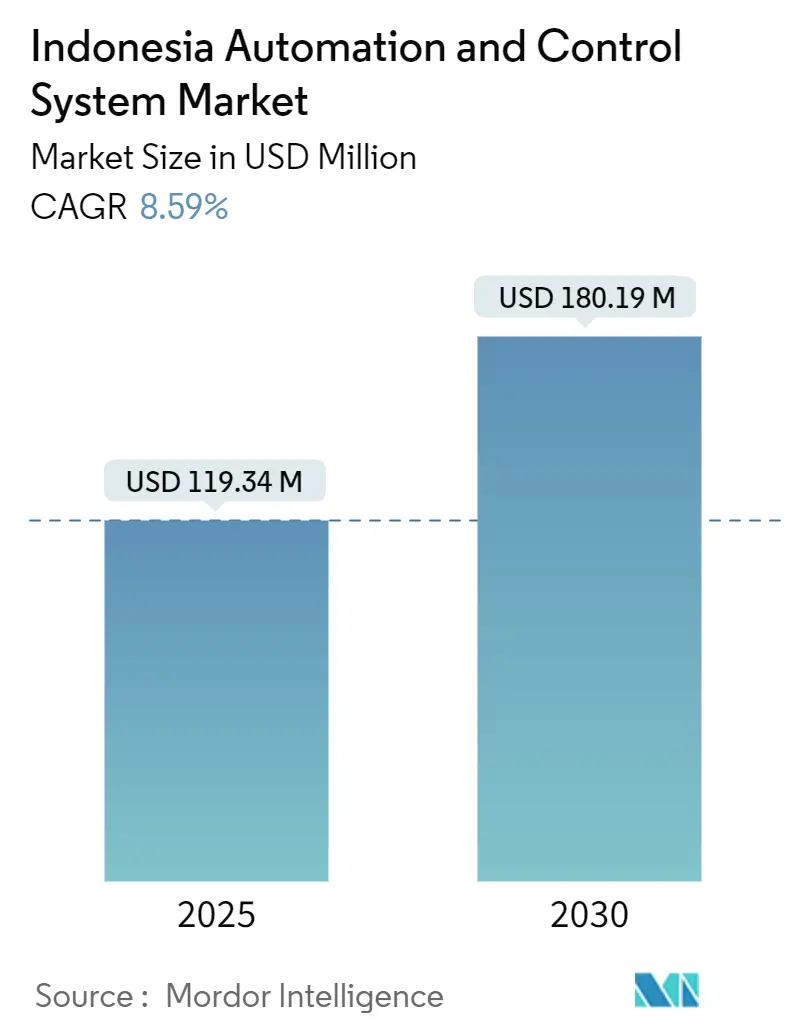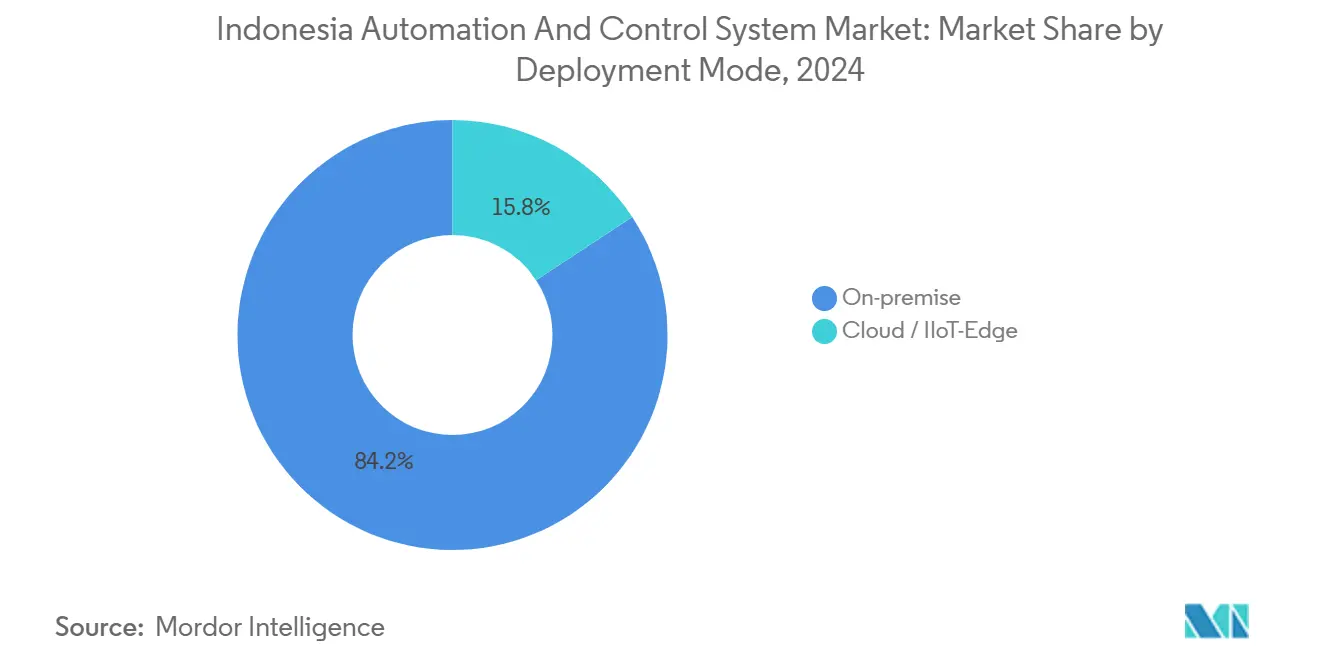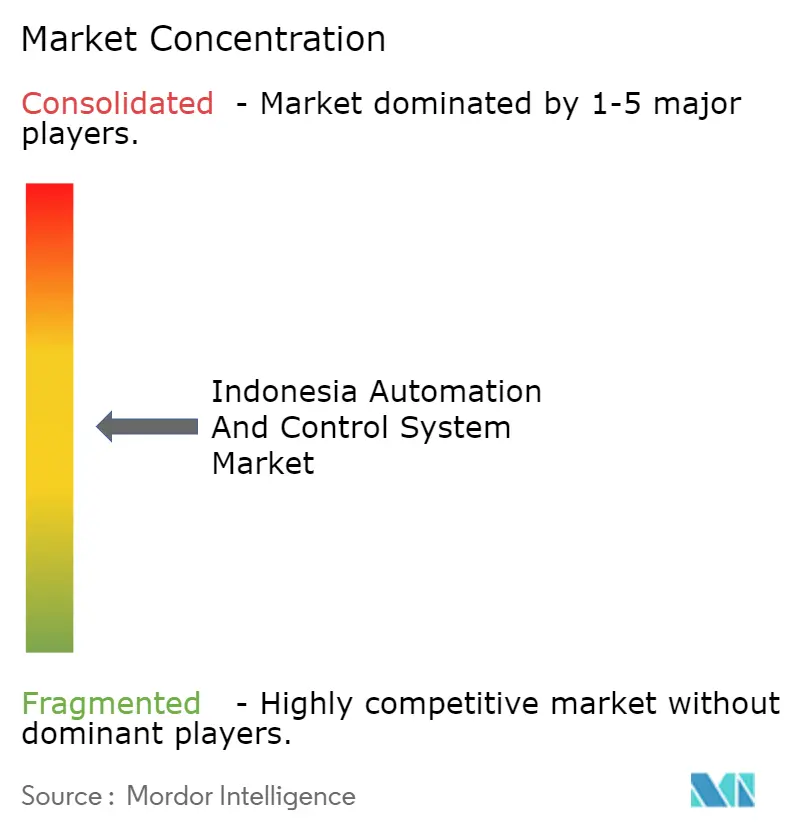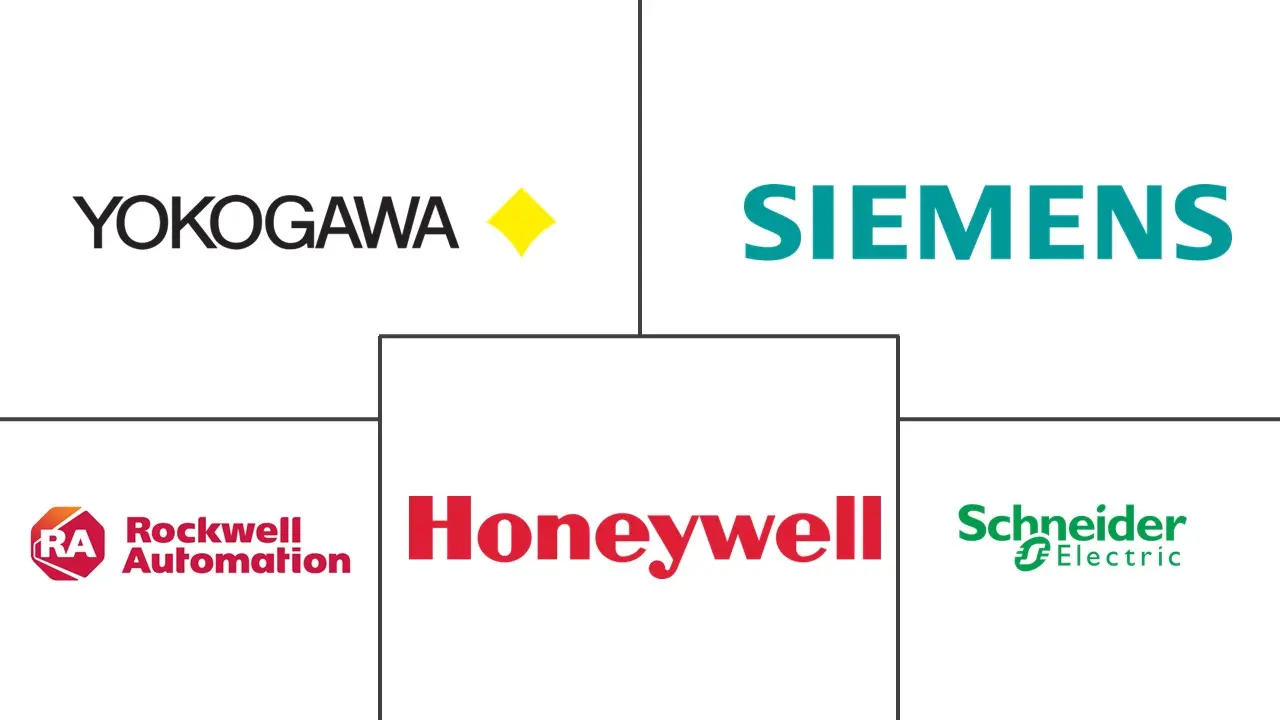Indonesia Automation And Control System Market Size and Share

Indonesia Automation And Control System Market Analysis by Mordor Intelligence
The Indonesia automation and control system market size reached USD 119.34 billion in 2025 and is forecast to climb to USD 180.19 billion by 2030, progressing at an 8.59% CAGR. The expansion reflects Jakarta’s drive to position the country as Southeast Asia’s manufacturing hub, the convergence of digital infrastructure with industrial capacity additions, and regulatory tailwinds that favour energy-efficient production. Government programs such as Making Indonesia 4.0, sizable power-sector capital expenditures, surging electric-vehicle investments, and relaxed local-content thresholds are opening procurement channels for global vendors even as domestic integrators scale up. Multinational suppliers are differentiating on predictive-maintenance software, cyber-secure architectures, and cloud-enabled platforms, while local service firms gain traction through cost-competitive integration and lifecycle support. These dynamics place the Indonesia automation and control system market at the center of a broader industrial modernization agenda that also improves energy security and export competitiveness.[1]Hogan Lovells, “Indonesia relaxes local content rules to energise green energy investment,” hoganlovells.com
Key Report Takeaways
- By product, Programmable Logic Controllers captured 27.06% of the Indonesia automation and control system market share in 2024, while Industrial Robotics is projected to record the fastest 10.11% CAGR through 2030.
- By component, hardware generated 61.55% revenue in 2024, whereas services are forecast to expand at the highest 9.89% CAGR as firms outsource predictive maintenance and system-integration tasks.
- By deployment mode, on-premises architectures held 84.24% share of the Indonesia automation and control system market size in 2024, yet cloud/IIoT-edge solutions will rise at a 10.77% CAGR given the growing appetite for remote analytics.
- By end-user industry, oil and gas led with 24.47% revenue share in 2024, while EV and battery manufacturing is advancing at an 11.04% CAGR on the back of new cell plants and upstream cathode investments.
Indonesia Automation And Control System Market Trends and Insights
Drivers Impact Analysis
| Driver | (~) % Impact on CAGR Forecast | Geographic Relevance | Impact Timeline |
|---|---|---|---|
| Flourishing power-sector capacity additions | +2.10% | National, concentrated in Java and Sumatra | Medium term (2-4 years) |
| Evolution of wireless sensor networks and protocols | +1.80% | National, early adoption in industrial zones | Short term (≤ 2 years) |
| Domestic "Making Indonesia 4.0" incentives | +1.50% | National, priority regions include Jakarta, Surabaya, Bandung | Long term (≥ 4 years) |
| Mandatory energy-efficiency standards for industry | +1.30% | National, focused on energy-intensive sectors | Medium term (2-4 years) |
| Surge in EV and battery manufacturing investments | +1.70% | Java and Sumatra, expanding to Kalimantan | Medium term (2-4 years) |
| AI-enabled predictive-maintenance demand | +1.20% | National, concentrated in manufacturing hubs | Long term (≥ 4 years) |
| Source: Mordor Intelligence | |||
Flourishing Power-Sector Capacity Additions
Massive generation and grid projects valued at IDR 51 trillion (USD 3.2 billion) are scaling demand for supervisory control and distributed control systems that coordinate renewable and thermal assets. State utility PLN is retrofitting excitation systems and deploying SCADA across hydro and coal plants to stabilize frequency as renewable penetration rises. The July 2024 decision to lower local-content rules below 30% widened the supplier pool and prompted multinationals to partner with Indonesian fabricators to meet sourcing quotas.[2]Deloitte Indonesia, “Energy and Resources Regulations Update (KM No.04/July/2024),” deloitte.com Yokogawa’s water-treatment SCADA in Bali and multiple PLN excitation retrofits in South Kalimantan illustrate the steady pipeline that supports the Indonesia automation and control system market.[3]Tender Indonesia, “Proyek Pembangunan Pabrik Sepatu Senilai 220 Juta USD,” tender-indonesia.com
Evolution of Wireless Sensor Networks and Protocols
5G rollout combined with lower-cost sensors is allowing factories to link conveyors, compressors, and HVAC systems without rewiring. PT Astra Daihatsu Motor cut fan energy use by 20% after connecting PLC-controlled motors to a wireless edge device, saving 122.66 kWh annually and avoiding 10.67 tCO₂ emissions. Manufacturers now stage analytics at the edge for real-time alarms while offloading pattern discovery to cloud dashboards, a configuration well suited to Indonesia’s archipelagic geography.
Domestic Making Indonesia 4.0 Incentives
Tax holidays, import-duty relief, and technology-transfer clauses motivate line builders to embed robotics, vision systems, and AI into priority sectors, including automotive and electronics. The SIINAS portal, mandated under Regulation 38/2018, tracks every automation purchase and its domestic-component ratio, giving policymakers granular insight into adoption gaps.[4]Business Indonesia, “SIINAS: Revolutionizing Indonesia's Industrial Sector with a Centralized Data Integration,” business-indonesia.org Thirteen partnership deals worth IDR 5 trillion (USD 315 million) signed at Hannover Messe 2024 point to sustained momentum.
Mandatory Energy-Efficiency Standards
New minimum-performance standards raise the bar for motor and drive efficiency. Plants that retrofit legacy motors with IE3-grade units and pair them with variable-speed drives can lower kWh per unit output by double digits. Insurance carriers also require certified safety-instrumented systems in high-pressure operations, adding another layer of compliance-driven automation spending.
Restraints Impact Analysis
| Restraint | (~) % Impact on CAGR Forecast | Geographic Relevance | Impact Timeline |
|---|---|---|---|
| High upfront CAPEX for brown-field retrofits | -1.40% | National, concentrated in legacy industrial facilities | Short term (≤ 2 years) |
| Skills gap in advanced automation engineering | -1.10% | National, acute in eastern Indonesia regions | Long term (≥ 4 years) |
| Volatile commodity pricing impacting Oil and Gas, mining | -0.80% | National, concentrated in resource-rich regions | Medium term (2-4 years) |
| Cyber-security concerns in OT networks | -0.70% | National, priority for critical infrastructure | Medium term (2-4 years) |
| Source: Mordor Intelligence | |||
High Upfront CAPEX for Brown-Field Retrofits
Older cement, steel, and petrochemical complexes must rewire control loops and train operators before installing advanced DCS. PT Rainbow Tubulars Manufacture is investing IDR 300 billion (USD 18.9 million) to modernize seamless pipelines, revealing the cash requirements that deter midsize firms from similar upgrades. Integration surprises between analog I/O and modern Ethernet-based systems often inflate budgets and extend shutdown windows.
Skills Gap in Advanced Automation Engineering
Universities still focus on general electrical engineering, leaving graduates under-exposed to cybersecurity layers, AI inference engines, and safety-integrity-level calculations. Employers fill the gap with expatriate consultants, raising project costs and limiting knowledge transfer. Government scholarships and vendor-run academies have begun to bridge the divide yet demand still outpaces supply.
Segment Analysis
By Product: Multifaceted Demand Anchored by PLCs and Propelled by Robotics
In 2024, PLCs generated 27.06% of revenue, confirming their ubiquity in packaging, material-handling, and batch-process lines. That domination secures a resilient base for the Indonesia automation and control system market size at the plant-floor level. However, Industrial Robotics is set to grow at a 10.11% CAGR through 2030, amplified by new automotive paint shops and electronics surface-mount lines that need micron-level repeatability. SCADA platforms gain steady orders from power utilities interested in distributed asset visualization, while DCS penetrates chemical and F&B plants where recipe integrity is mission-critical. HMI design is shifting toward capacitive touch and mobile mirroring, allowing supervisors to view KPIs from remote stations, an essential feature across Indonesia’s dispersed archipelago.
The safety-system niche is widening as insurers and regulators insist on SIL-3 emergency-shutdown loops, boosting demand for triple-modular-redundant PLCs and flame-scanner arrays. Efficiency mandates are pushing a shift from IE1 to IE3 motors, and the pairing of these units with variable-speed drives slashes energy bills and unlocks data for performance dashboards. Together, these trends underscore how hardware modernization and software orchestration are converging, reinforcing both the scale and the depth of the Indonesia automation and control system market.

Note: Segment shares of all individual segments available upon report purchase
By Component: Hardware Dominates While Services Accelerate
Hardware produced 61.55% of 2024 sales, encompassing controllers, sensors, actuators, and secure switches that underpin every automation architecture. Much of the capital spending in the Indonesia automation and control system market flows first into this stack as line builders outfit new capacities across automotive, EV, and FMCG verticals. Software demand is maturing from basic HMI to advanced analytics, historian integration, and anomaly detection, though it still trails hardware in total receipts.
Services will expand at a 9.89% CAGR through 2030 because manufacturers are outsourcing system integration, network re-engineering, and predictive-maintenance programs to specialists like PT Dycom Engineering, which reported USD 5.8 million revenue in 2025. Lifecycle contracts that bundle spares, firmware, cybersecurity patching, and operator training are particularly attractive to firms lacking deep in-house engineering benches. As installed bases age, the Indonesia automation and control system market share for service firms is poised to rise, diversifying revenue toward more recurring streams.
By Deployment Mode: Hybrid Architectures Gain Traction
On-premises deployment retained 84.24% revenue in 2024, a reflection of both legacy investments and the imperative to keep latency-sensitive control loops off public networks. Cyber-secure DMZs isolate plant networks from enterprise IT, meeting both production and compliance requirements. Nonetheless, cloud/IIoT-edge implementations are forecast to expand at a 10.77% CAGR, propelled by the cost-benefit of centralized analytics and multi-site benchmarking.
Edge gateways now preprocess vibration spectra, machine vision frames, and process anomalies before sending compressed insights to hyperscale clouds, lowering bandwidth expense and shortening response times. Vendors are pitching subscription packages that include device management, over-the-air firmware updates, and API connectors for ERP synchronization. The resulting hybrid ecosystems illustrate how the Indonesia automation and control system market balances sovereignty concerns with digital-transformation objectives.

By End-User Industry: Energy Anchors, EV Accelerates
Oil and gas maintained 24.47% of 2024 expenditure, spanning SCADA for onshore wells, DCS for refinery hydrocrackers, and rotating-equipment monitoring across LNG trains. The upstream segment alone commissioned dozens of PLC-based well-pad controls to meet production quotas and enhance safety. Power generation projects, spearheaded by PLN’s grid modernization, constituted the second-largest wallet share, demanding synchronous condensers, excitation upgrades, and renewable integration algorithms.
EV and battery manufacturing, though smaller in absolute terms, will clock an 11.04% CAGR as cathode, electrolyte, and cell lines spring up around Java industrial parks. Food and beverage processors are meanwhile adding traceability functions mandated by export buyers, elevating MES and vision-inspection uptake. Metals and mining operators are automating mill drives and smelter furnaces to curb energy intensity, while water-utility boards order remote telemetry for sewage treatment plants to meet environmental requirements. These vertical nuances shape solution roadmaps and fuel the long-term diversity of the Indonesian automation and control system market.
Geography Analysis
Java is the epicentre of demand, hosting automotive OEMs in Jakarta, semiconductor back-end fabs in Bandung, and chemical parks in Surabaya that together account for the bulk of the Indonesia automation and control system market size devoted to installed-base upgrades and new greenfield lines. Robust port logistics, skilled labour pools, and policy incentives, including accelerated depreciation for Industry 4.0 assets, reinforce its leadership.
Sumatra delivers a substantial share of spending through refineries, palm-oil downstream processors, and pulp and paper mills. State-owned Pertamina continues to retrofit SCADA across pipeline networks, while biodiesel plants in Riau adopt batch-reactor control to achieve consistent esterification yields. The coal-rich South Sumatra basin also drives process-automation procurements for washers and loading terminals.
Kalimantan, Sulawesi, and Papua form the frontier. Kalimantan’s nickel smelters and coal terminals require ruggedized PLC cabinets rated for high humidity and dust. Sulawesi’s cocoa grinders and seafood processors seek cost-effective HMIs and batch controls, while Papua’s mining concessions explore autonomous haulage communications to navigate rugged terrain. As special economic zones and transport corridors mature, these regions will grow their influence on the Indonesia automation and control system market, diversifying geographic revenue streams over the next decade.
Competitive Landscape
Multinational stalwarts Yokogawa, Siemens, ABB, Schneider Electric, Rockwell, and Honeywell lead complex projects that emphasize SIL-rated safety, ISA-95 compliance, and multi-vendor interoperability. They often manufacture panels or low-voltage assemblies locally to satisfy sourcing quotas, then layer proprietary software suites for lifecycle value capture. ABB’s agreement with SKF Industrial Indonesia illustrates this localization trend, combining Swiss drives with Indonesian bearings to bid on turnkey line expansions.
Local integrators such as PT Dycom Engineering and PT Menn Teknologi Indonesia carve out niches in mid-tier facilities by bundling mainstream PLCs with affordable HMIs and localized support contracts. Domestic panel shops leverage lower labour rates and intimate familiarity with local codes to compete on retrofit packages, especially in F&B and textile mills that require rapid turnaround. Emerging disruptors deploy AI-driven analytics and OT-security managed services, offering subscription pricing that appeals to CFOs keen on shifting capital expenses to operating outlays.
Competitive intensity escalated after July 2024 when local-content rules dipped below 30%, spurring fresh entries from Japanese, Korean, and European mid-cap OEMs. Price competition is tempered, however, by the technical complexity of most bids, which elevates vendor evaluation criteria such as cybersecurity readiness, lifecycle service footprints, and ability to meet aggressive commissioning windows. Collectively, these dynamics underscore a moderately fragmented yet professionalizing Indonesia automation and control system market.
Indonesia Automation And Control System Industry Leaders
-
Yokogawa Corporation
-
Siemens AG
-
Honeywell International Inc.
-
Rockwell Automation Inc.
-
Schneider Electric Co.
- *Disclaimer: Major Players sorted in no particular order

Recent Industry Developments
- March 2025: PT GoTo Gojek Tokopedia reported IDR 15.8 trillion (USD 17.9 billion) net revenue for 2024, up 8%, while trimming operating expenses by 27.6% through digital-platform optimization initiatives Validnews.
- February 2025: PT Indocement Tunggal Prakarsa released its 2023 Sustainability Report highlighting automation investments that cut kiln energy use and CO₂ emissions Indocement.
- January 2025: PT Rainbow Tubulars Manufacture broke ground on a second plant with IDR 300 billion (USD 18.9 million) capex, lifting seamless OCTG capacity to 70,000 tonnes annually Tender Indonesia.
- December 2024: PLN issued tenders for DEHC, BMS, and excitation retrofits at PLTU Asam Asam and PLTA Besai to modernize grid-connected assets Tender Indonesia.
Indonesia Automation And Control System Market Report Scope
Industrial automation is applying different and combined control systems to manage and operate machines and equipment in production facilities and factories. In addition to reducing costs, automation is being demanded to help increase productivity, aesthetics, efficiency, and delivery systems in the production of automotive assemblies, aircraft, steering and ship stabilization, heat-treating boilers and ovens, and other machinery.
Indonesia's automation and control system market is segmented by product (programmable logic controller, supervisory control and data acquisition, distributed control system, human-machine interface, safety systems, industrial robotics, electric motors, drives) and end-user industry (oil & gas, power, chemical & petrochemical, food & beverage, metals & mining, water, and wastewater).
The market sizes and forecasts are provided in terms of value in USD for all the above segments.
| Programmable Logic Controller (PLC) |
| Supervisory Control and Data Acquisition (SCADA) |
| Distributed Control System (DCS) |
| Human-Machine Interface (HMI) |
| Safety Systems |
| Industrial Robotics |
| Electric Motors (AC, DC, EC, Servo, Stepper) |
| Drives (AC, DC, Servo) |
| Hardware |
| Software |
| Services |
| On-premise |
| Cloud / IIoT-Edge |
| Oil and Gas |
| Power Generation |
| Chemical and Petrochemical |
| Food and Beverage |
| Metals and Mining |
| Water and Wastewater |
| Other End-User Industries |
| By Product | Programmable Logic Controller (PLC) |
| Supervisory Control and Data Acquisition (SCADA) | |
| Distributed Control System (DCS) | |
| Human-Machine Interface (HMI) | |
| Safety Systems | |
| Industrial Robotics | |
| Electric Motors (AC, DC, EC, Servo, Stepper) | |
| Drives (AC, DC, Servo) | |
| By Component | Hardware |
| Software | |
| Services | |
| By Deployment Mode | On-premise |
| Cloud / IIoT-Edge | |
| By End-User Industry | Oil and Gas |
| Power Generation | |
| Chemical and Petrochemical | |
| Food and Beverage | |
| Metals and Mining | |
| Water and Wastewater | |
| Other End-User Industries |
Key Questions Answered in the Report
What is the current value of the Indonesia automation and control system market?
The market stood at USD 119.34 billion in 2025 and is projected to reach USD 180.19 billion by 2030.
Which product category is growing the fastest?
Industrial Robotics is forecast to rise at a 10.11% CAGR through 2030 as automotive and electronics plants ramp up automation.
How large is the services opportunity in Indonesian factory automation?
Services are projected to advance at a 9.89% CAGR, reflecting growing demand for integration, predictive maintenance, and cybersecurity support.
Why are cloud and edge solutions gaining traction in Indonesia?
Hybrid architectures enable remote analytics while maintaining on-premise control, supporting a 10.77% CAGR for cloud/IIoT-edge deployments.
Which end-user sector offers the highest growth potential?
EV and battery manufacturing leads with an 11.04% CAGR on the back of sizable investments in cell and pack production capacity.
Page last updated on:



